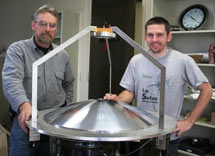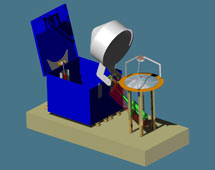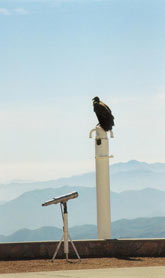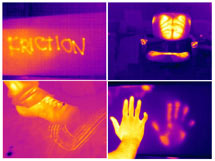
Handy Links
SLAC News Center
SLAC Today
- Subscribe
- Archives: Feb 2006-May 20, 2011
- Archives: May 23, 2011 and later
- Submit Feedback or Story Ideas
- About SLAC Today
SLAC News
Lab News
- Interactions
- Lightsources.org
- ILC NewsLine
- Int'l Science Grid This Week
- Fermilab Today
- Berkeley Lab News
- @brookhaven TODAY
- DOE Pulse
- CERN Courier
- DESY inForm
- US / LHC
SLAC Links
- Emergency
- Safety
- Policy Repository
- Site Entry Form

- Site Maps
- M & O Review
- Computing Status & Calendar
- SLAC Colloquium
- SLACspeak
- SLACspace
- SLAC Logo
- Café Menu
- Flea Market
- Web E-mail
- Marguerite Shuttle
- Discount Commuter Passes
-
Award Reporting Form
- SPIRES
- SciDoc
- Activity Groups
- Library
Stanford
Around the Bay
RASICAM: The Little Infrared Camera that Could
Perched on a peak high in the Chilean Andes, 2200 meters above sea level, the Cerro Tololo Inter-American Observatory has an enviable view of the night sky. In 2011, the Dark Energy Survey collaboration will install the largest digital camera ever built inside the Cerro Tololo dome to gaze deep into the universe. And sitting nearby, gazing at something a little closer to earth, will be the SLAC-built Radiometric All Sky Infrared Camera, or RASICAM.
With its 500 megapixels, the Fermilab-led DES camera, or DECam, will search the sky for evidence of dark energy, the mysterious force that seems to accelerate the expansion of the universe. To succeed in revealing the fundamentals of this dark 74 percent piece of the universe, the collaboration will need not only an extremely sensitive camera, advanced optics and a data acquisition system that can take a new photo every 17 seconds, but also a clear view of the night sky. This is where RASICAM fits in.
"DECam dwarfs RASICAM. But RASICAM plays an important role in DES observations," said SLAC Professor Rafe Schindler. "By instantaneously mapping high cloud distributions and contrails of airplanes at night, RASICAM will tell DECam if the atmospheric conditions in a particular direction are suitable for observing. Astronomers refer to this as ‘seeing.'"
RASICAM, which is being built at SLAC, will spend its nights searching for high-altitude cirrus clouds, the thin wispy clouds that are oftentimes a precursor to stormy weather. In addition, it will be on the lookout for contrails from airplanes that can drift into the field of view of the main camera. "These are a major irritant for astronomers," said Associate Engineer Howard Rogers, who is responsible for the mechanical design, fabrication, and installation of the RASICAM.
To see clouds 40,000 feet in the air even on the darkest nights, RASICAM will view the sky not in visible light but in infrared—essentially, heat. The water droplets in clouds and contrails emit infrared radiation, causing them to glow against the cooler background sky in RASICAM's infrared photos.
Many observatories already use such infrared cameras to determine which nights are clear enough for observations. The SLAC-designed model, however, incorporates several new and innovative design components. Unlike previous infrared cameras, which determine only whether there are clouds in the sky, RASICAM's state-of-the-art camera can determine the absolute temperature measured in each of its 76,800 pixels, and thus can create a detailed digital picture of where it's cloudy and where it's not. The unique curvature of the RASICAM gold-plated mirrors, which reflect infrared light into the camera, also ensures that an object will appear the same temperature no matter where in the sky it is.
"As far as we know, this is the first such camera in which the horizon doesn't appear hotter than the rest," said Stanford graduate student Peter Lewis, who designed the camera's optics, including the mirror's unique curvature. Lewis also modeled the system optically and is now writing the control and user-interface software. When the system is operational, anyone will be able to view the images of the Cerro Tololo sky in real-time, over the web.
RASICAM is also physically burlier than previous such cameras for a rather unexpected reason. "Midway through this project, we were told that Andean Condors [the largest flying land bird in the Western Hemisphere] are not uncommon in the region, and that these 30 pound birds might perch on our camera," Rogers said. "That's a rather unique design parameter," Lewis added. As a result, the design now calls for supporting struts made of stainless steel and spikes on the top of the structure to deter condors from resting there.
These new design elements—both the expected and the unexpected—will allow for the best cloud measurements possible over RASICAM's nearly all-sky field of view, keeping DECam operators up-to-date on clouds already in their way and those that will likely float through in the near future. RASICAM will take about 60 digital photos per second, add them together and refresh an image on the DECam operator's screen every 30 seconds.
Right now, the RASICAM components sit disassembled in SLAC's Central Laboratory. In the coming months, Rogers will draw on his experience building experimental aircraft to piece the instrument together and build a composite weather enclosure to protect the camera during the daytime and in bad weather. Rogers, Schindler and Lewis will then fly to Chile this August to install RASICAM at Cerro Tololo. Researchers plan to mount DECam onto the newly refurbished Cerro Tololo BLANCO telescope mid next year, and start up the camera before the end of 2011. Beginning in 2011 DECam and RASICAM will work together to shed light on dark energy.
"Pretty much every astronomical observatory needs an instrument like this," said Lewis. "We hope future observatories can use the RASICAM design for a lot more performance and, because we worked on a shoe-string budget, for less money."
With UC Santa Cruz, SLAC joined the DES collaboration in March 2009. To learn more about the Dark Energy Survey, see the Dark Energy Survey Web site and the SLAC Today article Dark Energy Survey Collaboration Meets at SLAC.
—Kelen Tuttle
SLAC Today, March 10, 2010




